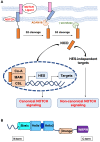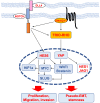Recent advances in understanding the role of HES6 in cancers
- PMID: 35673577
- PMCID: PMC9169368
- DOI: 10.7150/thno.72966
Recent advances in understanding the role of HES6 in cancers
Abstract
The NOTCH signaling system regulates a variety of cellular processes during embryonic development and homeostasis maintenance in different tissues and contexts. Hence, dysregulation of NOTCH signaling is associated with a plethora of human cancers, and there have been multiple efforts to target key components of this pathway. In this review, we briefly highlight the latest research advances in understanding HES6, a poorly studied component of the NOTCH pathway. We summarize the role of HES6 in cancers with a focus on uveal melanoma. Finally, we discuss the ongoing efforts to target the NOTCH-HES6 axis in cancers.
Keywords: HES6; NOTCH; cancers; signaling; uveal melanoma.
© The author(s).
Conflict of interest statement
Competing Interests: The authors have declared that no competing interest exists.
Figures





Similar articles
-
Single-cell RNA sequencing reveals intratumoral heterogeneity in primary uveal melanomas and identifies HES6 as a driver of the metastatic disease.Cell Death Differ. 2021 Jun;28(6):1990-2000. doi: 10.1038/s41418-020-00730-7. Epub 2021 Jan 18. Cell Death Differ. 2021. PMID: 33462406 Free PMC article.
-
HES6 promotes prostate cancer aggressiveness independently of Notch signalling.J Cell Mol Med. 2015 Jul;19(7):1624-36. doi: 10.1111/jcmm.12537. Epub 2015 Apr 12. J Cell Mol Med. 2015. PMID: 25864518 Free PMC article.
-
A novel hes5/hes6 circuitry of negative regulation controls Notch activity during neurogenesis.Dev Biol. 2005 May 15;281(2):318-33. doi: 10.1016/j.ydbio.2005.03.017. Dev Biol. 2005. PMID: 15893982
-
Hairless: the ignored antagonist of the Notch signalling pathway.Hereditas. 2006 Dec;143(2006):212-21. doi: 10.1111/j.2007.0018-0661.01971.x. Hereditas. 2006. PMID: 17362357 Review.
-
HES and HERP families: multiple effectors of the Notch signaling pathway.J Cell Physiol. 2003 Mar;194(3):237-55. doi: 10.1002/jcp.10208. J Cell Physiol. 2003. PMID: 12548545 Review.
Cited by
-
In Silico Pan-Cancer Analysis Reveals Prognostic Role of the Erythroferrone (ERFE) Gene in Human Malignancies.Int J Mol Sci. 2023 Jan 15;24(2):1725. doi: 10.3390/ijms24021725. Int J Mol Sci. 2023. PMID: 36675239 Free PMC article.
-
Subtypes and proliferation patterns of small intestine neuroendocrine tumors revealed by single-cell RNA sequencing.Elife. 2025 Jul 23;13:RP101153. doi: 10.7554/eLife.101153. Elife. 2025. PMID: 40699214 Free PMC article.
-
<i>HES6</i>knockdown in human hematopoietic precursor cells reduces their <i>in vivo</i> engraftment potential and their capacity to differentiate into erythroid cells, B cells, T cells and plasmacytoid dendritic cells.Haematologica. 2024 Nov 1;109(11):3578-3592. doi: 10.3324/haematol.2023.283432. Haematologica. 2024. PMID: 38572564 Free PMC article.
-
Hepatic Transcriptome Reveals Potential Key Genes Contributing to Differential Milk Production.Genes (Basel). 2024 Sep 20;15(9):1229. doi: 10.3390/genes15091229. Genes (Basel). 2024. PMID: 39336820 Free PMC article.
-
Need for a Dedicated Ophthalmic Malignancy Clinico-Biological Biobank: The Nice Ocular MAlignancy (NOMA) Biobank.Cancers (Basel). 2023 Apr 19;15(8):2372. doi: 10.3390/cancers15082372. Cancers (Basel). 2023. PMID: 37190299 Free PMC article. Review.
References
Publication types
MeSH terms
Substances
LinkOut - more resources
Full Text Sources
Medical

